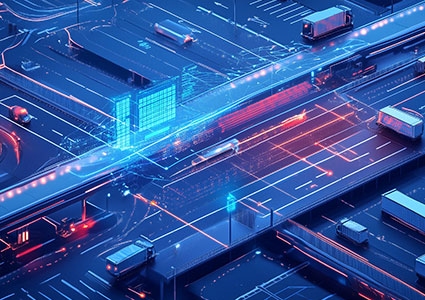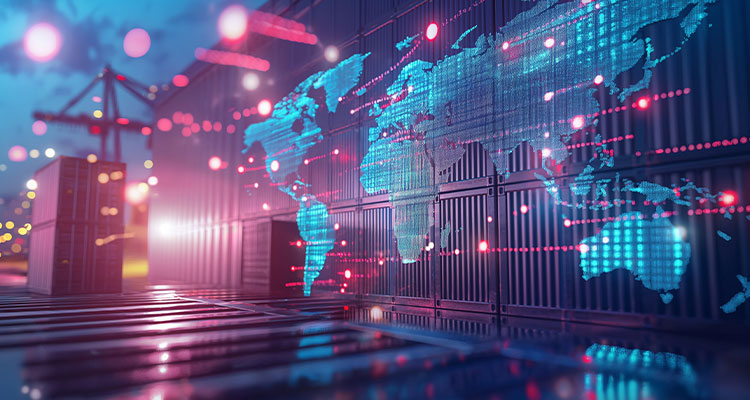The real impact of AI in modern logistics
Let’s cut through the hype and talk about what’s really happening with artificial intelligence in the business world. The numbers tell an interesting story; the AI market is on a meteoric rise. According to recent reports, the global AI market was valued at over $136 billion in 2023 and is projected to grow at an impressive compound annual growth rate (CAGR) of 37.3 percent between 2023 and 2030. But what matters isn’t the market size, it’s how companies are using this technology to drive value and a competitive advantage, especially in transportation and logistics.
One of the most compelling reasons for the rapid growth of AI adoption is its ability to tackle real-world business challenges. In logistics, companies embrace AI to streamline warehouse operations, optimize supply chains, and enhance customer satisfaction. 
What’s happening in AI right now
Two main players are helping shape the AI landscape: Machine Learning (ML) and Generative AI (GenAI). While ML has been around for a while, getting better at handling complex data, GenAI burst onto the scene recently, bringing new ways to process language and interpret information.
For folks in logistics, this couldn’t have come at a better time. Between supply chain headaches, worker shortages, and customers wanting everything yesterday, the industry needs smart tools that work. The good news? These tools are here, and they’re making a real difference.
Real examples that show AI’s worth
Want to see where AI shines? Look at warehouse storage problems. In the past, warehouse and inventory managers decided where to put products, which relied on gut feelings and spreadsheets. Now, ML spots patterns humans might miss, flagging when fast-moving items are stuck in awkward spots. This means less time wasted on restocking and fewer headaches for warehouse managers.
Here’s another win: ML now determines which products should sit next to each other on warehouse shelves. Think about items customers often buy together, like shampoo and conditioner. When these products are stored close to each other, workers spend less time walking around the warehouse.
It’s a simple change that adds up to major time savings.
Seeing into the future (sort of)
One of the coolest things AI does is help predict what’s coming. Warehouse managers used to struggle with guessing how many workers they’d need or how much space they’d use. ML now crunches the numbers and makes surprisingly accurate predictions, helping warehouses prepare for busy periods without guesswork.
For third-party logistics companies (3PLs), this predictive power extends to money matters. Instead of rough estimates, they’re using ML to forecast revenue with greater accuracy. This means better planning and smarter growth decisions based on real data, not just hunches.
The new kid on the block: GenAI

While ML keeps getting better at spotting patterns, GenAI is changing how we understand complex information. Take warehouse performance reports. Instead of drowning in data, managers now get clear explanations of what’s working and what isn’t, thanks to GenAI turning numbers into plain English.
Another game-changer is the GenAI shift starter tool. Think of it as a smart briefing that tells supervisors everything they need to know at the start of their shift; from how many orders need filling to which equipment is down for maintenance. It’s like having a well-informed assistant who never misses a detail.
Getting started without getting stuck
For companies wondering where to begin with AI, there’s a clear first step: move your data to the cloud. Specifically, look for what’s called a multi-tenant cloud setup. Think of it as putting all your information in one organized place (data lake) instead of scattered across disparate systems. This isn’t just about tidying up; it’s about making sure your data is ready for AI to work with it.
The key is starting with AI tools that solve real problems you’re facing right now. The examples we’ve talked about aren’t pie-in-the-sky ideas, they’re tools being used today to make warehouses run better, predict business trends more accurately, and help workers do their jobs more efficiently.
What this means for your business
The logistics industry is changing fast, and AI is a big part of that change. But this isn’t about replacing humans or completely overhauling how you work. It’s about adding smart tools that make everyone’s job a little easier and more productive.
Companies that start exploring these technologies now, beginning with organizing their data in the cloud, will be better prepared for whatever comes next. The companies seeing the best results aren’t necessarily the ones with the biggest budgets; they’re the ones thoughtfully applying AI to solve specific problems in their operations.
The bottom line? AI in logistics isn’t just hype anymore. It’s a practical set of tools making a real difference in how companies operate. The question isn’t whether to use AI but rather deciding which problems you want to tackle first.
For a list of the sources used in this article, please contact the editor.
Will Quinn
www.infor.com/en-gb
Will Quinn is Global Director of Strategy Warehouse Management at Infor and brings over 25 years of supply chain and logistics expertise to his role. His deep understanding of industry challenges empowers the sales team to navigate complex landscapes effectively. Infor is a global leader in business cloud software products for companies in industry specific markets. Infor builds complete industry suites in the cloud and efficiently deploys technology that puts the user experience first, leverages data science, and integrates easily into existing systems.
